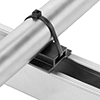Filter by
Material
Finish
Loop Height
Maximum Temperature
DFARS Specialty Metals
Export Control Classification Number (ECCN)
Flexibility
Minimum Temperature
Loop Length
Cable Installation Type
Building and Machinery Hardware
Electrical
Material Handling








































